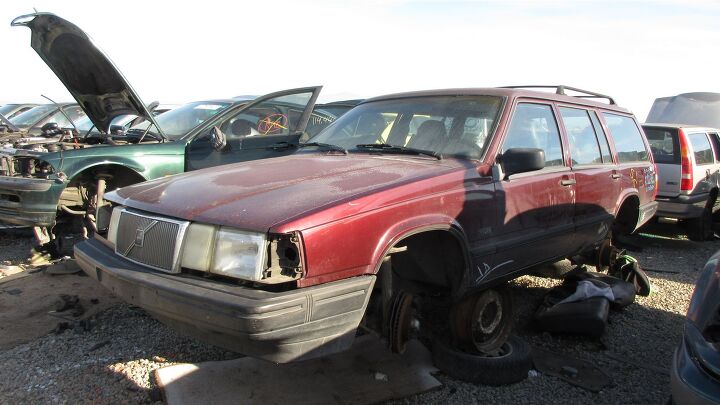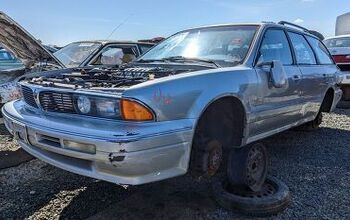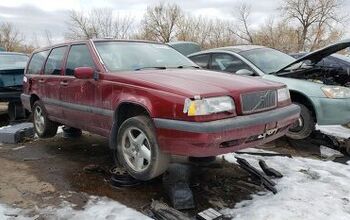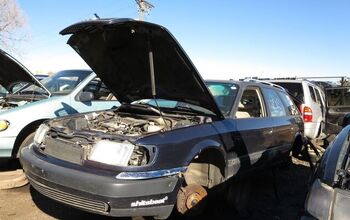Junkyard Find: 1994 Volvo 940 Turbo Wagon

The Volvo 900 Series replaced the 700 Series, which replaced the 200 Series, but — in true Volvo fashion — there was sufficient production overlap between these related models that all three were available at the same time for a couple of years in the early 1990s. The 940 sold well in the United States, but you’ll see more 240s and 740s today, perhaps due to the great affection held by Volvo fanatics for the “real” rear-wheel-drive Swedes.
I went into a Northern California wrecking yard determined to shoot the first 940 or 960 I saw, and that car turned out to be this 940 Turbo station wagon.
These cars were heavier and more complex than their predecessors, but the increased costs of maintenance and repair didn’t stop their owners from keeping them on the road for many years. This one made it to Toyota Camry territory on the odometer.
The paint is faded and the seats are upholstered in blue tape, signs that we’re not looking at a car owned by a fastidious garage-it-always type with a whisk broom in the glovebox.
Back in the early 2000s, I ferried a 940 Turbo Wagon across the country for my sister (later adding a pair of GMC van horns), and I was very impressed with the power out of the heavily-boosted 2.3-liter four-cylinder.
162 horses out of an engine this size was serious stuff in the 1990s. It’s easy to find turbochargers in California wrecking yards these days, unlike a few years ago, because every “tuner” kid who wants a bunch of turbos already has 19 of them in the garage.
In theory, a five-speed manual transmission was available in these cars. I have yet to see one.
Think of it as a limousine… for your luggage.
Back in the 940 Wagon’s homeland, it was all about the safety for pregnant women, ja.

Murilee Martin is the pen name of Phil Greden, a writer who has lived in Minnesota, California, Georgia and (now) Colorado. He has toiled at copywriting, technical writing, junkmail writing, fiction writing and now automotive writing. He has owned many terrible vehicles and some good ones. He spends a great deal of time in self-service junkyards. These days, he writes for publications including Autoweek, Autoblog, Hagerty, The Truth About Cars and Capital One.
More by Murilee Martin
Latest Car Reviews
Read moreLatest Product Reviews
Read moreRecent Comments
- Redapple2 Love the wheels
- Redapple2 Good luck to them. They used to make great cars. 510. 240Z, Sentra SE-R. Maxima. Frontier.
- Joe65688619 Under Ghosn they went through the same short-term bottom-line thinking that GM did in the 80s/90s, and they have not recovered say, to their heyday in the 50s and 60s in terms of market share and innovation. Poor design decisions (a CVT in their front-wheel drive "4-Door Sports Car", model overlap in a poorly performing segment (they never needed the Altima AND the Maxima...what they needed was one vehicle with different drivetrain, including hybrid, to compete with the Accord/Camry, and decontenting their vehicles: My 2012 QX56 (I know, not a Nissan, but the same holds for the Armada) had power rear windows in the cargo area that could vent, a glass hatch on the back door that could be opened separate from the whole liftgate (in such a tall vehicle, kinda essential if you have it in a garage and want to load the trunk without having to open the garage door to make room for the lift gate), a nice driver's side folding armrest, and a few other quality-of-life details absent from my 2018 QX80. In a competitive market this attention to detai is can be the differentiator that sell cars. Now they are caught in the middle of the market, competing more with Hyundai and Kia and selling discounted vehicles near the same price points, but losing money on them. They invested also invested a lot in niche platforms. The Leaf was one of the first full EVs, but never really evolved. They misjudged the market - luxury EVs are selling, small budget models not so much. Variable compression engines offering little in terms of real-world power or tech, let a lot of complexity that is leading to higher failure rates. Aside from the Z and GT-R (low volume models), not much forced induction (whether your a fan or not, look at what Honda did with the CR-V and Acura RDX - same chassis, slap a turbo on it, make it nicer inside, and now you can sell it as a semi-premium brand with higher markup). That said, I do believe they retain the technical and engineering capability to do far better. About time management realized they need to make smarter investments and understand their markets better.
- Kwik_Shift_Pro4X Off-road fluff on vehicles that should not be off road needs to die.
- Kwik_Shift_Pro4X Saw this posted on social media; “Just bought a 2023 Tundra with the 14" screen. Let my son borrow it for the afternoon, he connected his phone to listen to his iTunes.The next day my insurance company raised my rates and added my son to my policy. The email said that a private company showed that my son drove the vehicle. He already had his own vehicle that he was insuring.My insurance company demanded he give all his insurance info and some private info for proof. He declined for privacy reasons and my insurance cancelled my policy.These new vehicles with their tech are on condition that we give up our privacy to enter their world. It's not worth it people.”













































Comments
Join the conversation
You see 240s more than these partly because they sold better, and partly because they have a bigger following. I couldn't really get into these like I could the 240. The light lenses, seatbelt buttons, headliner, seats, hatch panel, door panels, all of these things were prone to cracking, not that 240s had great interiors but at least the headliners held up. Safely wasn't bad, but in offset collision tests at the time these cars kinda sucked (The VW Vanagon eats through these). I do recall that US turbo tranmsissions didn't get the lock up torque converter, it was too weak for our driving. Volvo did cheapen out the suspension on this model, something to do with the back links I think? Made them more prone to throwing their take out in spritied driving. My 91 740 at 197k was having issues going into reverse, piston slap, tea kettle noises, shot suspension everywhere, rattles galore, no AC, but the turbo still worked. Had terrible power around town (less than my NA 240s) but above 40mph and it'd start moving. Around here they're scarce, by '94 Volvo people had moved on to rust bucket Subarus, while the loyal held on to their discontinued 240s.
I've owned a baker's dozen RWD Volvos over the years. The 940 is a 240 with most of the stupid evolved out of it, and 240s have PLENTY of stupid baked into them. Courtesy of being an early '60s design that was never intended to have the sorts of even minimal creature comforts they acquired by end of production. There is simply no universe in which it is cheaper to run a 240 than a 940, it's just a better engineered car all around with a lot fewer built-in dilemmas.